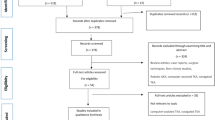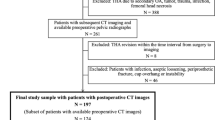Abstract
Background
Total hip arthroplasty (THA) has evolved over the years to be a reliable, reproducible, and successful orthopedic procedure. Nowadays, THA is increasingly performed on patients using less invasive, tissue-preserving techniques. Accordingly, the use of computer navigation in total joint arthroplasty has become more prevalent. However, there is still lack of high-quality evidence to verify the most effective technique for THA.
Methods
A search was conducted in PubMed, Medline, Embase, Cochrane Central Register of Controlled Trials, and Google Scholar databases. Clinical trials published from 1966 to Feb 2012 that assess conventional techniques THA or computer-navigated techniques THA for placing the acetabular component. The main outcome measures included abduction angles, anteversion angles, percentage of acetabular outliers, operation time, decrease in Hb/24 h, and wound secretion/48 h.
Results
The pooled analysis across all studies showed a significant difference in anteversion angles and acetabular outliers (difference −0.22, 95 % CI −0.67, 0.24; p = 0.346, I 2 = 71.9 %) and (difference 8.34, 95 % CI 4.15, 16.74; p = 0.000, I 2 = 0.0 %). However, no significant difference in abduction angle and decrease in Hb/24 h (difference −0.22, 95 % CI −0.67, 0.24; p = 0.346, I 2 = 71.9 %) and (difference 0.03, 95 % CI −0.36, 0.41; p = 0.888, I 2 = 0.0 %). For the operation time, computer-navigated THA was longer (difference −0.73, 95 % CI −1.32, −0.15; p = 0.014, I 2 = 74.4 %).
Conclusions
This meta-analysis demonstrated computer-navigated THA was a more favorable method for placing the acetabular component and decreased the number of acetabular cups implanted outside the desired range of alignment. More high-quality RCTs were needed to support the evidence.







Similar content being viewed by others
References
Callaghan JJ, Albright JC, Goetz DD, Olejniczak JP, Johnston RC (2000) Charnley total hip arthroplasty with cement. Minimum twenty-five-year follow-up. J Bone Joint Surg Am 82:487–497
Lewinnek GE, Lewis JL, Tarr R, Compere CL, Zimmerman JR (1978) Dislocations after total hip-replacement arthroplasties. J Bone Joint Surg Am 60:217–220
Saxler G, Marx A, Vandevelde D, Langlotz U, Tannast M, Wiese M, Michaelis U, Kemper G, Grutzner PA, Steffen R, von Knoch M, Holland-Letz T, Bernsmann K (2004) Cup placement in hip replacement surgery—a comparison of free-hand and computer assisted cup placement in total hip arthroplasty a multi-center study. Z Orthop Ihre Grenzgeb 142:286–291
Tannast M, Langlotz F, Kubiak-Langer M, Langlotz U, Siebenrock KA (2005) Accuracy and potential pitfalls of fluoroscopy-guided acetabular cup placement. Comput Aided Surg 10:329–336
Honl M, Schwieger K, Salineros M, Jacobs J, Morlock M, Wimmer M (2006) Orientation of the acetabular component. A comparison of five navigation systems with conventional surgical technique. J Bone Joint Surg Br 88:1401–1405
Pierchon F, Pasquier G, Cotten A, Fontaine C, Clarisse J, Duquennoy A (1994) Causes of dislocation of total hip arthroplasty: CT study of component alignment. J Bone Joint Surg 76-B:45–48
DeWal H, Su E, DiCesare PE (2003) Instability following total hip arthroplasty. Am J Orthop 32:377–382
Parratte S, Argenson JN (2007) Validation and usefulness of a computer-assisted cup-positioning system in total hip arthroplasty. A prospective, randomized, controlled study. J Bone Joint Surg 89(3):494–499
Sendtner E, Schuster T, Wörner M, Kalteis T, Grifka J, Renkawitz T (2011) Accuracy of acetabular cup placement in computer-assisted, minimally-invasive THR in a lateral decubitus position. Int Orthop 35(6):809–815
Reininga IH, Zijlstra W, Wagenmakers R, Boerboom AL, Huijbers BP, Groothoff JW, Bulstra SK, Stevens M (2010) Minimally invasive and computer-navigated total hip arthroplasty: a qualitative and systematic review of the literature. BMC Musculoskelet Disord 17(11):92
Leenders T, Vandevelde D, Mahieu G, Nuyts R (2002) Reduction in variability of acetabular cup abduction using computer assisted surgery: a prospective and randomized study. Comput Aided Surg 7(2):99–106
Kalteis T, Handel M, Herold T, Perlick L, Baethis H, Grifka J (2005) Greater accuracy in positioning of the acetabular cup by using an image-free navigation system. Int Orthop 29(5):272–276
Kalteis T, Handel M, Bäthis H, Perlick L, Tingart M, Grifka J (2006) Imageless navigation for insertion of the acetabular component in total hip arthroplasty: is it as accurate as CT-based navigation? J Bone Joint Surg Br 88(2):163–167
Lin F, Lim D, Wixson RL, Milos S, Hendrix RW, Makhsous M (2011) Limitations of imageless computer-assisted navigation for total hip arthroplasty. J Arthroplasty 26(4):596–605
Manzotti A, Cerveri P, De Momi E, Pullen C, Confalonieri N (2011) Does computer-assisted surgery benefit leg length restoration in total hip replacement? Navigation versus conventional freehand. Int Orthop 35(1):19–24
Gandhi R, Marchie A, Farrokhyar F, Mahomed N (2009) Computer navigation in total hip replacement: a meta-analysis. Int Orthop 33(3):593–597
Conflict of interest
The authors declare that they have no conflict of interest.
Author information
Authors and Affiliations
Corresponding author
Additional information
Yu-Lin Li and Jun Jia have equal contribution to this research.
Rights and permissions
About this article
Cite this article
Li, YL., Jia, J., Wu, Q. et al. Evidence-based computer-navigated total hip arthroplasty: an updated analysis of randomized controlled trials. Eur J Orthop Surg Traumatol 24, 531–538 (2014). https://doi.org/10.1007/s00590-013-1222-1
Received:
Accepted:
Published:
Issue Date:
DOI: https://doi.org/10.1007/s00590-013-1222-1




